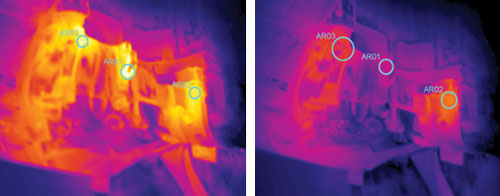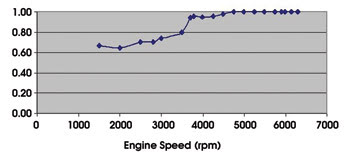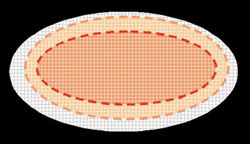Process provides global temperature distribution data.
Leonard A. Phillips, Flir Systems
Infrared thermography inspection has become a powerful tool in the automotive research and development toolbox, not only saving time and expense, but also adding the unique advantage of radiometric imaging. Two recent examples of IR thermography in high-temperature applications include aluminum die-casting process optimization and catalytic converter design.
Exco Engineering, a company in Newmarket, Ontario, Canada, that specializes in die-casting services for clients such as DaimlerChrysler and General Motors, has allocated an infrared camera for its die-casting process development program. Since the infrared thermography inspection tool was introduced, Exco has used internal and external, time-sequence and space-distribution monitoring technologies for the program.
Previously, the company used a thermocouple-based temperature unit to monitor and control the thermal status of the die. Changhua Huang, an R&D engineer, said that, although the system’s physical limitations allowed it to track the thermal status of certain internal areas of the die, it could not provide the global temperature distribution.
In contrast, the infrared camera can image and measure the surface temperatures of an entire casting, a quantum improvement over the point-sampling provided by thermocouples. Exco found that infrared thermography inspection can easily detect extreme hot spots on a mold’s cavity surfaces (Figure 1).
Huang said that an extreme hot spot is frequently the bottleneck to shortening cycle times, requiring more careful and time-consuming cooling. In addition, the hot spot can adversely affect the quality of the casting because it may cool with different metallurgical characteristics than cooler areas. Using continuous, real-time IR thermal imaging, the external cooling spray that is used to maintain temperatures in the die can be tuned to maximize the external cooling efficiency (Figure 2). Optimizing the cooling-spray scheme can improve the casting quality and shorten the cycle time by about 30 percent.

Figures 1 and 2. This thermograph of the cavity area of a cover die for a transmission case taken before an external cooling spray (left) demonstrates the hot spots AR01, AR02 and AR03. After the external cooling spray, the hottest spot on the same cover die (AR01) was cooled, and the other hot spots were reduced to an acceptable level (right). Photos by C. Huang.
Rafael Royo Pastor, a professor at the Universidad Politécnica de Valencia in Spain, has reported the results of an ongoing 10-year R&D effort involving the university and the Renault engineering center in Valladolid, Spain. Researchers used an infrared camera to image the surface temperature of a hot catalytic converter in a Renault 1.6-liter, fuel-injected, spark-ignition gasoline engine. The internal temperatures of the exhaust gases flowing inside were then calculated using internal and external convection coefficients from the correlations available for forced laminar convection conditions. They took into account the small size of the exhaust gas passageways and the thermal properties of the gases (Figure 3). Because of the insulating effect caused by relatively still gas in the active passageways closest to the shell of the converter, the temperatures of the external surface and the internal gases were substantially different, approaching ΔT = 200 K for the highest engine speeds (Figure 4).

Figure 3. An estimate of the fraction of effective flow section of the catalytic converter vs. engine speed is provided in this graph. For the lowest engine speeds, the flow fills only about 60 percent of the section of the converter. Figures courtesy of Rafael Royo Pastor.
The methodology also has been applied to other types of flows and geometries; for example, in the exhaust gas recirculation system. From the studies carried out for spark ignition and diesel engines, the researchers made a number of discoveries. A major one was that the distribution of the exhaust gases inside the catalytic converter is not uniform. It flows mostly through the central part of the device, so the rest of the swept volume acts as insulating material, where relatively still exhaust gases remain in the cells of the structure, depending on the load and the engine speed.

Figure 4. This cross section of a catalytic converter illustrates the progressive “filling” of a section with increasing mass flow rates. The active passageways closest to the shell of the converter are filled with relatively still gas, providing an insulating effect.
They also learned that, at full-load conditions, heat losses from the surface of the engine could be quantified as equivalent to 50 percent of the maximum engine power. Maximum heat losses are produced at the exhaust part of the engine, where the radiation intensity is very high. The temperature of the main portion of the engine surface is about 95 to 100 °C, similar to that of the coolant water. This is reasonable when you factor in the high thermal conductivity of the materials currently used in the aluminum engine walls.
For the turbocharged diesel engines common in Europe, IR measurements determined that the zone surrounding the turbine can reach 600 °C. It is important to take into account these thermal levels because a high thermal charge is involved even if the heat transfer surface is not too large.
Meet the author
Leonard A. Phillips is senior writer for infrared applications at Flir Systems in North Billerica, Mass. He previously was a senior editor of Technology Review at Massachusetts Institute of Technology.